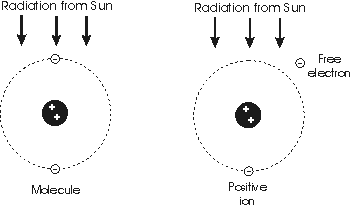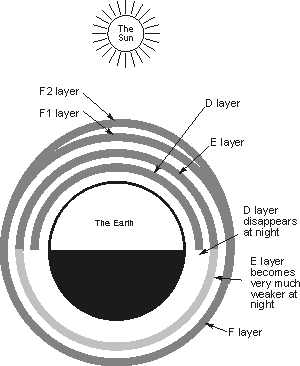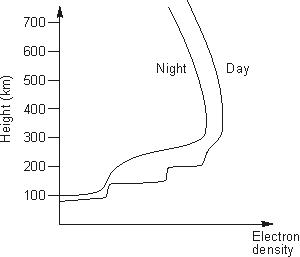The Ionosphere and Radiowave Propagation
- an overview or tutorial about the ionosphere, and how it affects radiowave
propagation and radio communications.
The ionosphere is a particularly important region with
regards to radio signal propagation and radio communications in general. Its
properties govern the ways in which radio communications, particularly in the HF
radio communications bands take place.
The ionosphere is a region of the upper atmosphere where
there are large concentrations of free ions and electrons. While the ions give
the ionosphere its name, but it is the free electrons that affect the radio
waves and radio communications. In particular the ionosphere is widely known for
affecting signals on the short wave radio bands where it "reflects" signals
enabling these radio communications signals to be heard over vast distances.
Radio stations have long used the properties of the ionosphere to enable them to
provide worldwide radio communications coverage. Although today, satellites are
widely used, HF radio communications using the ionosphere still plays a major
role in providing worldwide radio coverage.
The ionosphere extends over more than one of the
meteorological areas, encompassing the mesosphere and the thermosphere, it is an
area that is characterised by the existence of positive ions (and more
importantly for radio signals free electrons) and it is from the existence of
the ions that it gains its name.
Basics
The free electrons do not appear over the whole of the
atmosphere. Instead it is found that the number of free electrons starts to rise
at altitudes of approximately 30 kilometres. However it is not until altitudes
of around 60 to 90 kilometres are reached that the concentration is sufficiently
high to start to have a noticeable effect on radio signals and hence on radio
communications systems. It is at this level that the ionosphere can be said to
start.
The ionisation in the ionosphere is caused mainly by
radiation from the Sun. In addition to this, the very high temperatures and the
low pressure result in the gases in the upper reaches of the atmosphere existing
mainly in a monatomic form rather than existing as molecules. At lower
altitudes, the gases are in the normal molecular form, but as the altitude
increases the monatomic forms are more in abundance, and at altitudes of around
150 kilometres, most of the gases are in a monatomic form. This is very
important because it is found that the monatomic forms of the gases are very
much easier to ionise than the molecular forms.
Ionisation
The Sun emits vast quantities of radiation of all wavelengths
and this travels towards the Earth, first reaching the outer areas of the
atmosphere. In creating the ionisation it is found that when radiation of
sufficient intensity strikes an atom or a molecule, energy may be removed from
the radiation and an electron removed, producing a free electron and a positive
ion. In the example given below, the simple example of a helium atom is give,
although other gases including oxygen and nitrogen are far more common.

Ionisation of molecules by solar radiation
The radiation from the Sun covers a vast spectrum of
wavelengths. However in terms of the effect it has on the atoms of molecules it
can be considered as photons. The electrons in the atoms or molecules can be
considered as orbiting the central nucleus consisting of protons and neutrons.
Electrons are tied or bound to their orbit around the nucleus by electro-static
forces, the electron is negatively charged and the nucleus is positively
charged. There are equal numbers of electrons and protons in any molecule and as
a result it is electro-statically neutral.
When a photon strikes the atom, or molecule, the photon
transfers its energy to the electron as excess kinetic energy. Under some
circumstances this excess energy may exceed the binding energy in the atom or
molecule and the electron escapes the influence of the positive charge of the
nucleus. This leaves a positively charged nucleus or ions and a negatively
charged electron, although as there are the same number of positive ions and
negative electrons the whole gas still remains with an overall neutral charge.
Most of the ionisation in the ionosphere results from
ultraviolet light, although this does not mean that other wavelengths do not
have some effect. Additionally, each time an atom or molecule is ionised a small
amount of energy is used. This means that as the radiation passes further into
the atmosphere, its intensity reduces. It is for this reason that the
ultraviolet radiation causes most of the ionisation in the upper reaches of the
ionosphere, but at lower altitudes the radiation that is able to penetrate
further cause more of the ionisation. Accordingly, extreme ultra-violet and
X-Rays give rise to most of the ionisation at lower altitudes. This reduction in
these forms of radiation protects us on the surface of the Earth from the
harmful effects of these rays.
The level of ionisation varies over the extent of the
ionosphere, being far from constant. One reason is that the level of radiation
reduces with decreasing altitude. Also the density of the gases varies. In
addition to this there is a variation in the proportions of monatomic and
molecular forms of the gases, the monatomic forms of gases being far greater at
higher altitudes. These and a variety of other phenomena mean that there are
variations in the level of ionisation with altitude.
The level of ionisation in the ionosphere also changes with
time. It varies with the time of day, time of year, and according to many other
external influences. One of the main reasons why the electron density varies is
that the Sun, which gives rise to the ionisation is only visible during the day.
While the radiation from the Sun causes the atoms and molecules to split into
free electrons and positive ions. The reverse effect also occurs. When a
negative electron meets a positive ion, the fact that dissimilar charges attract
means that they will be pulled towards one another and they may combine. This
means that two opposite effects of splitting and recombination are taking place.
This is known as a state of dynamic equilibrium. Accordingly the level of
ionisation is dependent upon the rate of ionisation and recombination. This has
a significant effect on radio communications.

A simplified view of the layers in the ionosphere over
the period of a day
Other effects like the season and the state of the Sun also
have a major effect. Sunspots and solar disturbances have a major impact on the
level of radiation received, and these effects are covered in other articles on
this website on Sunspots and Solar Disturbances. The season also has an effect.
Again this is covered in other articles on the Radio-Electronics.Com website.
However very briefly, the radiation received from the Sun varies in the same way
that heat from the Sun varies according to the season, and accordingly the level
of ionisation and free electrons changes. However this is a very simplified view
as other facts also come into play.
Ionospheric layers
The traditional view of the ionosphere indicates a number of
distinct layers, each affecting radio communications in slightly different ways.
Indeed, the early discoveries of the ionosphere indicated that a number of
layers were present. While this is a convenient way of picturing the structure
of the ionosphere it is not exactly correct. Ionisation exists over the whole of
the ionosphere, its level varying with altitude. The peaks in level may be
considered as the different layers or possibly more correctly, regions. These
regions are given letter designations: D, E, and F regions. There is also a C
region below the others, but the level of ionisation is so low that it does not
have any effect radio signals and radio communications, and it is rarely
mentioned.

The typical electron distribution in the ionosphere
The different layers or regions in the ionosphere have
different characteristics and affect radio communications in different ways.
There are also differences in the exact way they are created and sustained. In
view of this it is worth taking a closer look at each one in detail and the way
they vary over the complete day during light and darkness.
D Region
The D region is the lowest of the regions within the
ionosphere that affects radio communications signals to any degree. It is
present at altitudes between about 60 and 90 kilometres and the radiation within
it is only present during the day to an extent that affects radio waves
noticeably. It is sustained by the radiation from the Sun and levels of
ionisation fall rapidly at dusk when the source of radiation is removed. It
mainly has the affect of absorbing or attenuating radio communications signals
particularly in the LF and MF portions of the radio spectrum, its affect
reducing with frequency. At night it has little effect on most radio
communications signals although there is still a sufficient level of ionisation
for it to refract VLF signals.
The layer is chiefly generated by the action of a form of
radiation known as Lyman radiation which has a wavelength of 1215 Angstroms and
ionises nitric oxide gas present in the atmosphere. Hard X-Rays also contribute
to the ionisation, especially towards the peak of the solar cycle.
E Region
The region above the D region is the E region. It exists at
altitudes between about 100 and 125 kilometres. Instead of attenuating radio
communications signals this layer chiefly refracts them, often to a degree where
they are returned to earth. As such they appear to have been reflected by this
layer. However this layer still acts as an attenuator to a certain degree.
Like the D region, the level of ionisation falls relatively
quickly after dark as the electrons and ions re-combine and it virtually
disappears at night. However the residual night time ionisation in the lower
part of the E region causes some attenuation of signals in the lower portions of
the HF part of the radio communications spectrum.
The ionisation in this region results from a number of types
of radiation. Soft X-Rays produce much of the ionisation, although extreme
ultra-violet (EUV) rays (very short wavelength ultra-violet light) also
contribute. Broadly the radiation that produces ionisation in this region has
wavelengths between about 10 and 100 Angstroms. The degree to which all of the
constituents contribute depends upon the state of the Sun and the latitude at
which the observations are made.
F Region
The most important region in the ionosphere for long distance
HF radio communications is the F region. During the daytime when radiation is
being received from the Sun, it often splits into two, the lower one being the
F1 region and the higher one, the F2 region. Of these the F1 region is more of
an inflection point in the electron density curve (seen above) and it generally
only exists in the summer.
Typically the F1 layer is found at around an altitude of 300
kilometres with the F2 layer above it at around 400 kilometres. The combined F
layer may then be centred around 250 to 300 kilometres. The altitude of the all
the layers in the ionosphere layers varies considerably and the F layer varies
the most. As a result the figures given should only be taken as a rough guide.
Being the highest of the ionospheric regions it is greatly affected by the state
of the Sun as well as other factors including the time of day, the year and so
forth.
The F layer acts as a "reflector" of signals in the HF
portion of the radio spectrum enabling world wide radio communications to be
established. It is the main region associated with HF signal propagation.
Like the D and E layers the level of ionisation of the F
region varies over the course of the day, falling at night as the radiation from
the Sun disappears. However the level of ionisation remains much higher. The
density of the gases is much lower and as a result the recombination of the ions
and electrons takes place more slowly, at about a quarter of the rate that it
occurs in the E region. As a result of this it still has an affect on radio
signals at night being able to return many to Earth, although it has a reduced
effect in some aspects.
The F region is at the highest region in the ionosphere and
as such it experiences the most solar radiation. Much of the ionisation results
from ultra-violet light in the middle of the spectrum as well as those portions
of the spectrum with very short wavelengths. Typically the radiation that causes
the ionisation is between the wavelengths of 100 and 1000 Angstroms, although
extreme ultra-violet light is responsible for some ionisation in the lower areas
of the F region.
Summary
The ionosphere is a continually changing area of the
atmosphere. Extending from altitudes of around 60 kilometres to more than 400
kilometres it contains ions and free electrons. The free electrons affect the
ways in which radio waves propagate in this region and they have a significant
effect on HF radio communications.
The ionosphere can be categorised into a number of regions
corresponding to peaks in the electron density. These regions are named the D,
E, and F regions. In view of the fact that the radiation from the Sun is
absorbed as it penetrates the atmosphere, different forms of radiation give rise
to the ionisation in the different regions as outlined in the summary table
below:
Summary of forms of radiation causing ionisation in
the ionosphere.
| Region |
Primary Ionising Radiation Forms |
| C |
Cosmic |
| D |
Lyman alpha, Hard X-Rays |
| E |
Soft X-Rays and some Extreme Ultra-Violet |
| F1 |
Extreme Ultra-violet, and some Ultra-Violet |
| F2 |
Ultra-Violet |
The ionosphere is a continually changing area. It is
obviously affected by radiation from the Sun, and this changes as a result
aspects including of the time of day, the geographical area of the world, and
the state of the Sun. As a result radio communications using the ionosphere
change from one day to the next, and even one hour to the next. Predicting how
what radio communications will be possible and radio signals may propagate is of
great interest to a variety of radio communications users ranging from
broadcasters to radio amateurs and two way radio communications systems users to
those with maritime mobile radio communications systems and many more.
|

